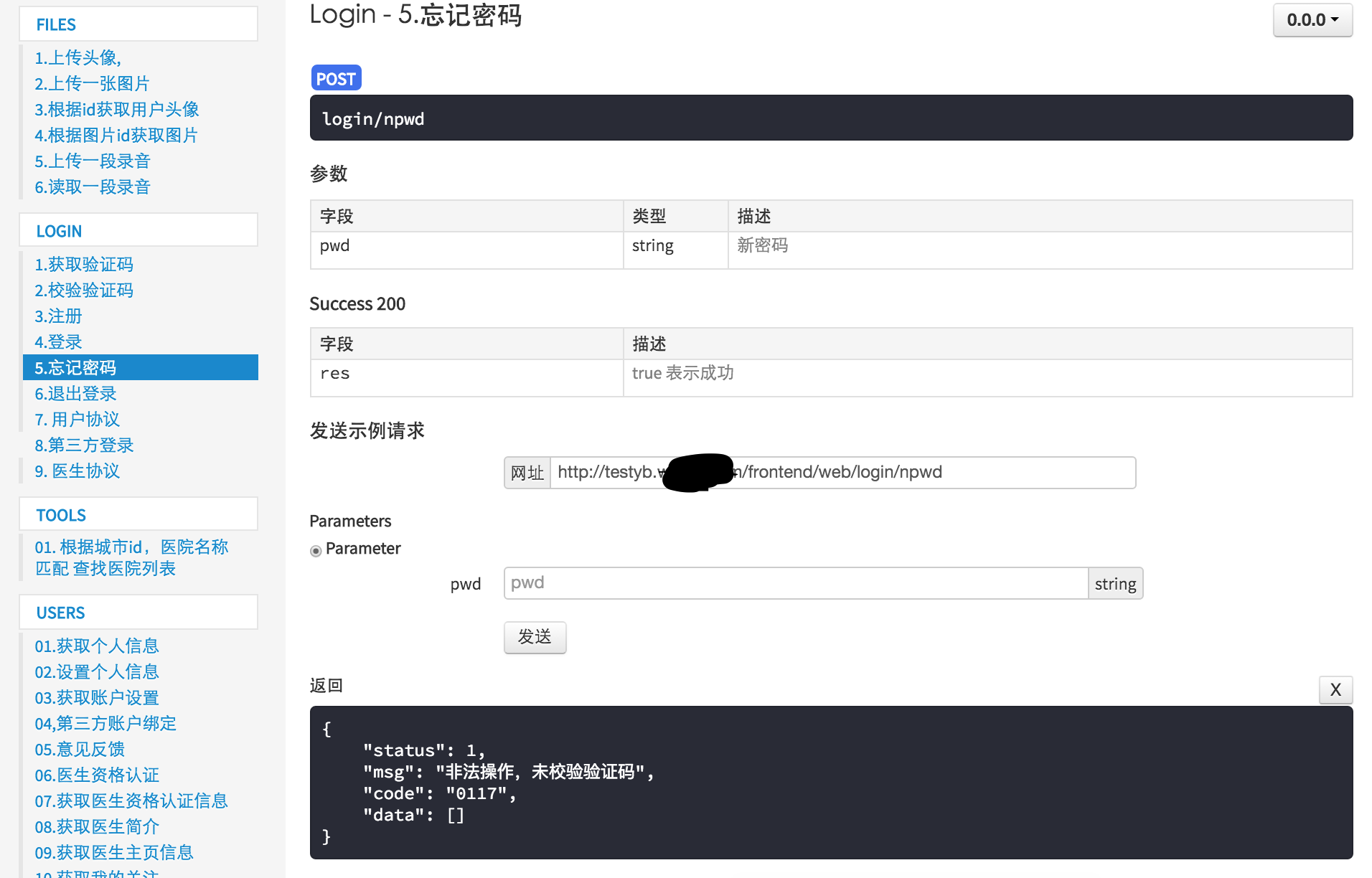apidoc可以根据代码注释生成web api文档,支持大部分主流语言java javascript php coffeescript erlang perl python ruby go...,相对而言,web接口的注释维护起来更加方便,不需要额外再维护一份文档。
apidoc从注释生成静态html网页文档,不仅支持项目版本号,还支持api版本号。
安装
主页: http://apidocjs.com
github: https://github.com/apidoc/apidoc
可以使用npm install apidoc -g进行安装,目前0.12.x/4.0都可以使用。
apidoc支持Grunt,主页 https://github.com/apidoc/grunt-apidoc
- 在项目中使用
npm install grunt-apidoc --save-dev安装。 - 在
Gruntfile.js添加grunt.loadNpmTasks('grunt-apidoc');。 - 配置
grunt task
apidoc: { myapp: { src: "app/", dest: "apidoc/" } }
// 在sails中2和3可以直接添加一个taskmodule.exports = function(grunt) { grunt.config.set('clean', { apidoc: { myapp: { src: "app/", dest: "apidoc/" } } }); grunt.loadNpmTasks('grunt-apidoc'); };
用法
可以在shell中执行apidoc -h就可以看到很多用法。
下面讲讲常用的几个参数。
// 典型用法 apidoc -i api/ -o doc/api [-c ./] -f ".*.js$" -i 表示输入,后面是文件夹路径 -o 表示输出,后面是文件夹路径 默认会带上-c,在当前路径下寻找配置文件(apidoc.json),如果找不到则会在package.json中寻找 "apidoc": { } -f 为文件过滤,后面是正则表达式,示例为只选着js文件 与-f类似,还有一个 -e 的选项,表示要排除的文件/文件夹,也是使用正则表达式 如果项目输入和输出稳定,可以编辑Makefile保存命令,例如: docs: @apidoc -i api/ -o doc/apidoc
之后使用make docs即可生成/更新api文档。
配置
项目配置
apidoc.json示例:
{ "name" : "mysails", "version": "1.0.0", "title": "mysails", // 浏览器标题 "description": "xun's test project" }
如果放入package.json中,相同的字段可以直接使用package.json的定义,额外的字段放入apidoc下
{ "name": "mysails", "private": true, "version": "1.0.0", "description": "xun's test project", "apidoc": { "title": "mysails" }, ... }
代码注释
apidoc支持如下关键字
@api {method} path [title] 只有使用@api标注的注释块才会在解析之后生成文档,title会被解析为导航菜单(@apiGroup)下的小菜单 method可以有空格,如{POST GET} @apiGroup name 分组名称,被解析为导航栏菜单 @apiName name 接口名称,在同一个@apiGroup下,名称相同的@api通过@apiVersion区分,否者后面@api会覆盖前面定义的@api @apiDescription text 接口描述,支持html语法 @apiVersion verison 接口版本,major.minor.patch的形式 @apiIgnore [hint] apidoc会忽略使用@apiIgnore标注的接口,hint为描述 @apiSampleRequest url 接口测试地址以供测试,发送请求时,@api method必须为POST/GET等其中一种 @apiDefine name [title] [description] 定义一个注释块(不包含@api),配合@apiUse使用可以引入注释块 在@apiDefine内部不可以使用@apiUse @apiUse name 引入一个@apiDefine的注释块 @apiParam [(group)] [{type}] [field=defaultValue] [description] @apiHeader [(group)] [{type}] [field=defaultValue] [description] @apiError [(group)] [{type}] field [description] @apiSuccess [(group)] [{type}] field [description] 用法基本类似,分别描述请求参数、头部,响应错误和成功 group表示参数的分组,type表示类型(不能有空格),入参可以定义默认值(不能有空格) @apiParamExample [{type}] [title] example @apiHeaderExample [{type}] [title] example @apiErrorExample [{type}] [title] example @apiSuccessExample [{type}] [title] example 用法完全一致,但是type表示的是example的语言类型 example书写成什么样就会解析成什么样,所以最好是书写的时候注意格式化,(许多编辑器都有列模式,可以使用列模式快速对代码添加*号) @apiPermission name name必须独一无二,描述@api的访问权限,如admin/anyone
示例:
定义一个200的返回结果
/** js * @apiDefine CODE_200 * @apiSuccess (Reponse 200) {number} code 200 * @apiSuccess (Reponse 200) {json} [data='""'] 如果有数据返回 * @apiSuccessExample {json} Response 200 Example * HTTP/1.1 200 OK * { * "code": 200, * "data": "" * } */
定义一个500的返回结果
/** * @apiDefine CODE_500 * @apiSuccess (Response 500) {number} code 500 * @apiSuccess (Response 500) {string} [message] error description * @apiSuccessExample {json} Response 500 Example * HTTP/1.1 500 Internal Server Error * { * "code": 500 * "message": "xxx" * } */
定义接口
/** * @apiDefine Data * * @apiParam (data) {string} [firstname] Optional Firstname of the User. * @apiParam (data) {string} lastname Mandatory Lastname. * @apiParam (data) {string} country="cn" Mandatory with default value "DE". * @apiParam (data) {number} [age=18] Optional Age with default 18. */ /** * @api {POST GET} /api/test/hello[/:id] /api/test/hello[/:id] * @apiName test api * @apiGroup Hello World * @apiVersion 1.0.0 * @apiDescription just a test * @apiPermission anyone * @apiSampleRequest http://test.github.com * * @apiParam {number} [id] any id * @apiParam {json} data object * @apiUse Data * * @apiParamExample {json} Request Example * POST /api/test/hello/1 * { * "data": { * "firstname": "test", * "lastname": "sails", * "country": "cn" * } * } * * @apiUse CODE_200 * @apiUse CODE_500 */
最后生成文档之后,结果如下所示

文/xun(简书作者)
原文链接:http://www.jianshu.com/p/bb5a4f5e588a
著作权归作者所有,转载请联系作者获得授权,并标注“简书作者”。
原文链接:http://www.jianshu.com/p/bb5a4f5e588a
著作权归作者所有,转载请联系作者获得授权,并标注“简书作者”。